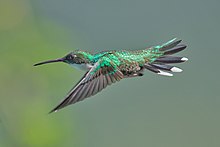White-throated hummingbird
| White-throated hummingbird | ||||||||||
|---|---|---|---|---|---|---|---|---|---|---|

White-throated hummingbird |
||||||||||
| Systematics | ||||||||||
|
||||||||||
| Scientific name of the genus | ||||||||||
| Leucochloris | ||||||||||
| Reichenbach , 1854 | ||||||||||
| Scientific name of the species | ||||||||||
| Leucochloris albicollis | ||||||||||
| ( Vieillot , 1818) |
The white-throated hummingbird ( Leucochloris albicollis ) is a species of bird in the hummingbird family (Trochilidae). The distribution area of this monotypical species includes the countries Argentina , Paraguay , Uruguay , Bolivia and Brazil . The IUCN assesses the population as Least Concern .
features
The white-throated hummingbird reaches a body length of about 11.5 cm, with the wings 6.3 cm, the tail 36 mm and the beak 22 mm long. It weighs approx. 8 g. The top, the elytra, the chest and the flanks shine green. The green chin is lined with white feathers. The wings are blackish purple. The throat, the center of the abdomen and a small spot behind the eyes are white. The steel-blue tail feathers shine greenish in the middle, while the lateral truncated, narrow control springs have white tips. The upper bill is black, the lower bill flesh-colored with a dark tip. The feet are blackish brown. There is no such thing as gender dimorphism .
Young birds have pink-red feather edges on the upper side.
distribution and habitat
The distribution area stretches from the east of Bolivia over the east of Paraguay, the north of Argentina and the southeast of Brazil. The species is also found occasionally in Uruguay. In Brazil, its range extends from the state of Minas Gerais to Rio Grande do Sul . Here the birds like to stay in the treetops near forest edges, gardens, plantations and parks at altitudes below 1300 meters.
behavior
Not much is known about the behavior of this hummingbird.
Reproduction
The nests are approx. 50 mm high. The outer radius is approx. 40 mm, the inner radius approx. 32 mm with a nest depth of approx. 18 mm. The eggs weigh about 0.65 g and are about 16 × 9 mm in size. The incubation period is 14 days, the young birds after hatch for 25 days Nesthocker are. The breeding season is the period from November to March.
Vocalizations
Their call consists of irregular, inconspicuous tjek-tjek-tjek sounds.
Etymology and history of research
Louis Pierre Vieillot described the hummingbird under the name Trochilus albicollis . The bellows for the first description came from Brazil and were made available to Vieillot by the Muséum national d'histoire naturelle and from the private collection of Guillaume Michel Jérôme Meiffren de Laugier, Baron of Chartrouse (1772–1843). When Ludwig Reichenbach published an extra booklet with the systematics of the hummingbirds in an addendum to the assembly of German ornithologists , he added this species to the new genus Leucochloris .
The word “Leucochloris” is of Greek origin and is made up of the words “leukós λευκός ” for “white” and “khlōros χλωρός ” for “green”. The specific epithet “albicollis” is a Latin combination of “albus” for “white” and “collis” for “neck”.
literature
- Rolf Grantsau : The hummingbirds of Brazil . A key for all hummingbird shapes in Brazil. Expressão e Cultura, Rio de Janeiro 1988, ISBN 978-85-208-0101-7 .
- Ber Van Perlo: A Field Guide to the Birds of Brazil . Oxford University Press, Oxford 2009, ISBN 978-0-19-530155-7 .
- James A. Jobling: Helm Dictionary of Scientific Bird Names . Christopher Helm, London 2010, ISBN 978-1-4081-2501-4 .
- Louis Pierre Vieillot: Nouveau dictionnaire d'histoire naturelle, appliquée aux arts, à l'agriculture, à l'économie rurale et domestique, à la médecine, etc. Par une société de naturalistes et d'agriculteurs . tape 23 . Deterville, Paris 1818 ( online [accessed May 14, 2013]).
- Heinrich Gottlieb Ludwig Reichenbach: Enumeration of the hummingbirds or trochilids in their true natural relationship with key to their synonymy . In: Journal of Ornithology . tape 2 , special issue, 1854, p. 1-24 ( online [accessed May 14, 2013]).
Web links
- Leucochloris albicollis in the endangered Red List species the IUCN 2012. Posted by: BirdLife International, 2012.2. Retrieved April 10, 2013.
- BirdLife International: Species Factsheet - White-throated Hummingbird ( Leucochloris albicollis ) . Retrieved April 10, 2013.
- Videos, photos and sound recordings of White-throated Hummingbird (Leucochloris albicollis) in the Internet Bird Collection
- White-throated hummingbird ( Leucochloris albicollis ) at Avibase; Retrieved April 10, 2013.
- Leucochloris albicollis in the Integrated Taxonomic Information System (ITIS). Retrieved April 10, 2013.
- xeno-canto: Sound recordings - White-throated Hummingbird ( Leucochloris albicollis )
- White-throated Hummingbird (Leucochloris albicollis) in the Encyclopedia of Life . Retrieved May 2, 2019.


